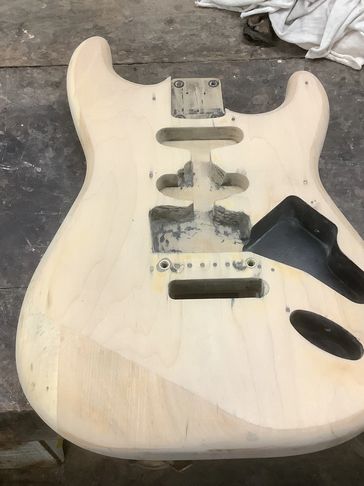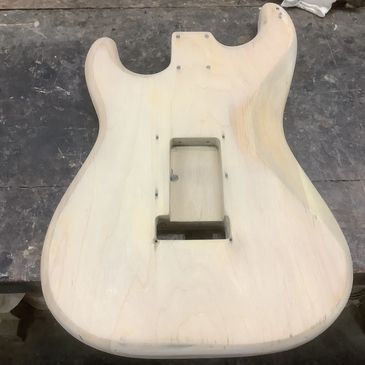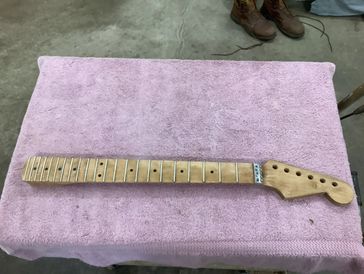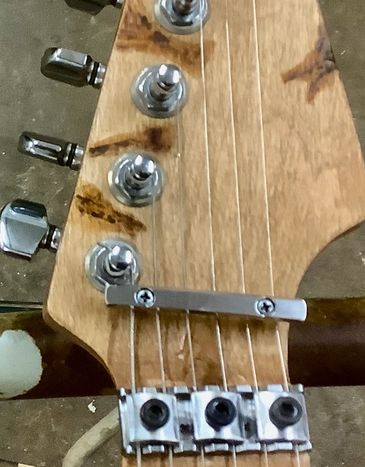REPLICA EVH STRATOCASTER

The Body
A used Stratocaster body from the late 80’s was chosen for this project. It was washed in a degreasing solvent and let dry. This is done to remove any oil or contaminates that would prevent the paint from adhearing. The bridge and center pick-up cavity were hand cut to match the original guitar.

The back was treated exactly the same as the front, sides and interior portions. All surfaces were carefully inspected to insure that they were clean and ready for step 2 of the preparation process.

The Neck
The Neck
Two new necks were purchased new and both were exactly the same. The neck on the left was cut down to specs for this project, and the right was left alone for another project. Degreasing was not necessary here.

The Neck
Closer look of the final cut of the headstock. A template that I made was used to get the right size and shape.

The plastic nut was removed, and the area was cut out to accept a locking nut configuration.

Locking nut installed. The purpose for a locking nut is to keep the guitar in tune as the tremolo bar is depressed repeatedly. The strings run through the slots like a standard nut, but are clamped down with 3 individual pieces of metal with an Allen bolt. Photo 12 shows the close up.

1st step of aging the neck. 2 more steps are necessary to achieve the right look.

Back of the neck gets the same treatment.

Final color but not distressed yet.

Tuning pegs and locking nut are installed, and cigarette burns are finished.

Getting there! Striping is done, electronics are installed and tested, neck is bolted on and bridge and strings are set.

Close up on the locking nut fully installed. The bar that the strings run underneath is to keep the strings from whining due to the design of the neck and headstock.

A view of the back with a broken reflector and heavy distressing.

Close up with broken reflector.

Right side view

Left side with heavy distressing completed.

View of the bottom, with the 1971 quarter on the lower left side of the Floyd Rose bridge and distressing here too.

The famous quarter. The purpose of the quarter is to tune down the guitar at will by depressing the tremolo bar and pivoting the quarter underneath the corner of the bridge.

Close-up of the quarter pictured which was distressed and aged to fit with the rest of the metals. All metals were aged to give a sense of something that was heavily used in the ‘80’s.

And there it is! A project that took 9 months to do, but loved every minute of it. I worked on it in my spare time, and on weekends.

Looks great in the office next to my ‘57 Fender American Vintage 2 Stratocaster.
Copyright © 2024 J.R.Panetta Furniture Restoration,LLC All Rights Reserved.
This website uses cookies.
We use cookies to analyze website traffic and optimize your website experience. By accepting our use of cookies, your data will be aggregated with all other user data.